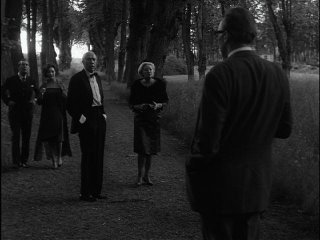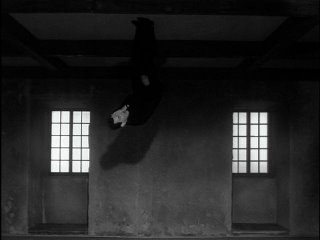 Following his masterpiece, Persona, Ingmar Bergman released this updated fairy tale; but, in modernity, the Dark Forest is the soul in the absense of God. Here, Bergman deals once again with the issues of madness and the permeability of the self that he dealt with in that earlier film. In a sense, Hour of the Wolf remakes Persona to much different effect.
Following his masterpiece, Persona, Ingmar Bergman released this updated fairy tale; but, in modernity, the Dark Forest is the soul in the absense of God. Here, Bergman deals once again with the issues of madness and the permeability of the self that he dealt with in that earlier film. In a sense, Hour of the Wolf remakes Persona to much different effect.As in that film, Hour of the Wolf deals with an artist who isolates himself to escape his own demons, but who is persued by those demons and actually sacrifices his wife to the same creatures.
 Here though, the wife Alma is all-too-ready to psychically merge with the husband. She tells him: “I hope that we will get so old that we think each other’s thoughts and we get little, dried-up, identical wrinkled faces.” Soon, the spectors haunting her husband's subconscious come calling for Alma too. Or, perhaps they really are the aristocrats who live in the island's castle. If the horrors are illusions, then the majority of the film is an illusion, but we never can tell.
Here though, the wife Alma is all-too-ready to psychically merge with the husband. She tells him: “I hope that we will get so old that we think each other’s thoughts and we get little, dried-up, identical wrinkled faces.” Soon, the spectors haunting her husband's subconscious come calling for Alma too. Or, perhaps they really are the aristocrats who live in the island's castle. If the horrors are illusions, then the majority of the film is an illusion, but we never can tell.
Walter Benjamin once wrote that "There are two ways to miss the point of Kafka's works. One is to interpret them naturally. The other is the supernatural interpretation." Kafka's Castle Hill is an obvious reference point in the film, and the advice seems to hold here as well. Are the strange aristocrats really vampires? Or, are they hallucinations of the artist's increasingly unstable mind? Neither answer is totally satisfying- the first ignores the extremely personal nature of the story, and the second does not explain why they haunt Alma as well. However, taking the creatures as being the artist's hallucinations makes the story a highly sympathetic portrait of a woman in love with a mentally ill man. She says: "They're trying to separate us. They want you for themselves. As long as I'm with you, it's much harder for them. Johan, I won't run away no matter how hard they try!" Notice that, in one context this can be taken as a very moving section of dialogue, while in another it is a scene in a horror film.
Again following Persona, Bergman sees human relationships as impossible and uses vampire imagery as a metaphor for those relationships. Again the artist is destroyed by society, here quite literally. Again Bergman deals with issues of mental illness, finding them not only intimately connected to creativity, but perhaps to modern life as such. As in Through a Glass Darkly, the secondary character's infinite kindness is spent trying to save a loved one who is haunted by terrifying hallucinations- here again the mentally ill sees God as a spider. But, here there is the suggestion that others can catch mental illness, or even that we are all doomed to eventually succumb to it. Only a director with Bergman's history of institutionalization would dare to suggest such a thing, and even worse, he creates a world in which we cannot answer him.
1 comment:
replica ysl bags australia replica bags from korea replica bags joy
Post a Comment